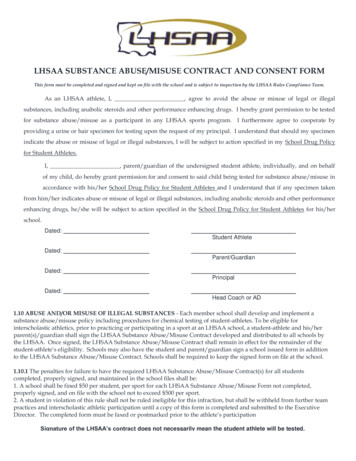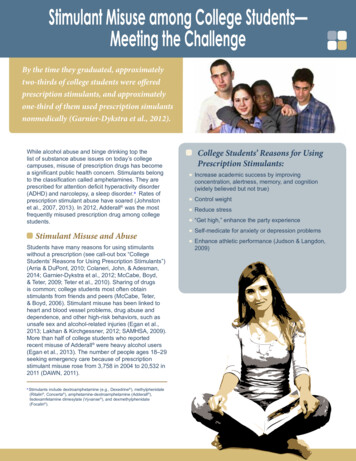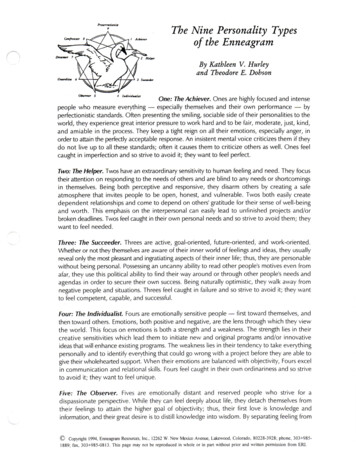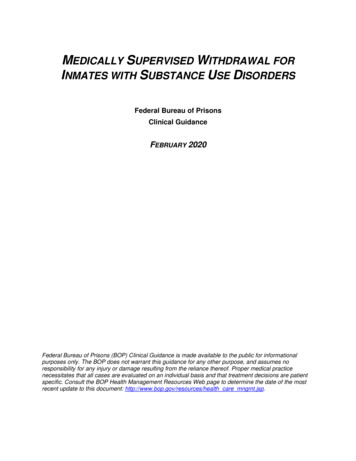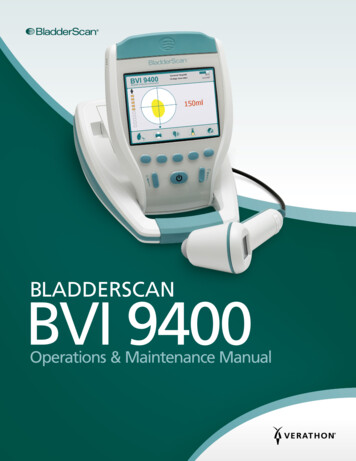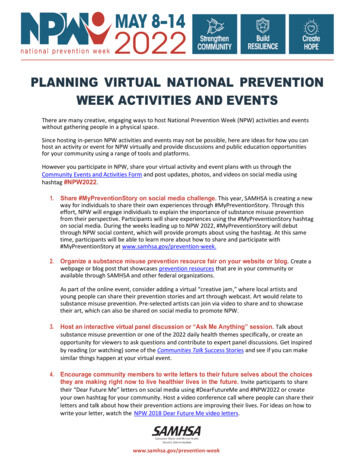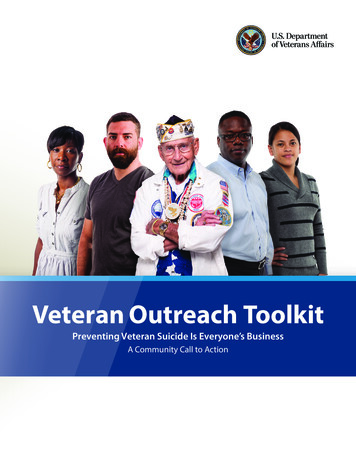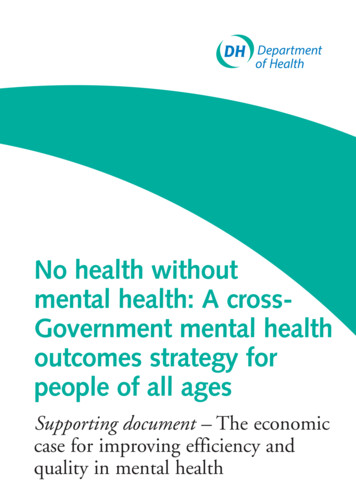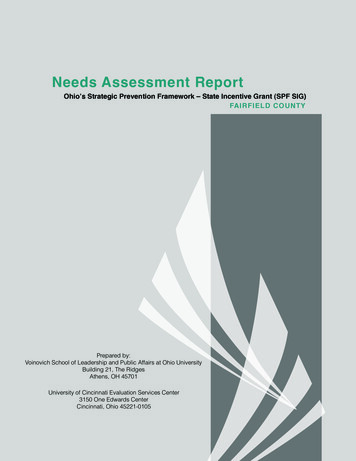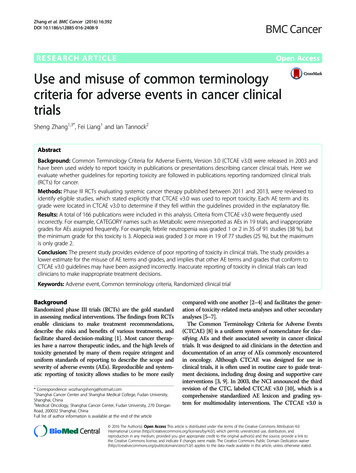
Transcription
Zhang et al. BMC Cancer (2016) 16:392DOI 10.1186/s12885-016-2408-9RESEARCH ARTICLEOpen AccessUse and misuse of common terminologycriteria for adverse events in cancer clinicaltrialsSheng Zhang1,3*, Fei Liang1 and Ian Tannock2AbstractBackground: Common Terminology Criteria for Adverse Events, Version 3.0 (CTCAE v3.0) were released in 2003 andhave been used widely to report toxicity in publications or presentations describing cancer clinical trials. Here weevaluate whether guidelines for reporting toxicity are followed in publications reporting randomized clinical trials(RCTs) for cancer.Methods: Phase III RCTs evaluating systemic cancer therapy published between 2011 and 2013, were reviewed toidentify eligible studies, which stated explicitly that CTCAE v3.0 was used to report toxicity. Each AE term and itsgrade were located in CTCAE v3.0 to determine if they fell within the guidelines provided in the explanatory file.Results: A total of 166 publications were included in this analysis. Criteria from CTCAE v3.0 were frequently usedincorrectly. For example, CATEGORY names such as Metabolic were misreported as AEs in 19 trials, and inappropriategrades for AEs assigned frequently. For example, febrile neutropenia was graded 1 or 2 in 35 of 91 studies (38 %), butthe minimum grade for this toxicity is 3. Alopecia was graded 3 or more in 19 of 77 studies (25 %), but the maximumis only grade 2.Conclusion: The present study provides evidence of poor reporting of toxicity in clinical trials. The study provides alower estimate for the misuse of AE terms and grades, and implies that other AE terms and grades that conform toCTCAE v3.0 guidelines may have been assigned incorrectly. Inaccurate reporting of toxicity in clinical trials can leadclinicians to make inappropriate treatment decisions.Keywords: Adverse event, Common terminology criteria, Randomized clinical trialBackgroundRandomized phase III trials (RCTs) are the gold standardin assessing medical interventions. The findings from RCTsenable clinicians to make treatment recommendations,describe the risks and benefits of various treatments, andfacilitate shared decision-making [1]. Most cancer therapies have a narrow therapeutic index, and the high levels oftoxicity generated by many of them require stringent anduniform standards of reporting to describe the scope andseverity of adverse events (AEs). Reproducible and systematic reporting of toxicity allows studies to be more easily* Correspondence: wozhangsheng@hotmail.com1Shanghai Cancer Center and Shanghai Medical College, Fudan University,Shanghai, China3Medical Oncology, Shanghai Cancer Center, Fudan University, 270 DonganRoad, 200032 Shanghai, ChinaFull list of author information is available at the end of the articlecompared with one another [2–4] and facilitates the generation of toxicity-related meta-analyses and other secondaryanalyses [5–7].The Common Terminology Criteria for Adverse Events(CTCAE) [8] is a uniform system of nomenclature for classifying AEs and their associated severity in cancer clinicaltrials. It was designed to aid clinicians in the detection anddocumentation of an array of AEs commonly encounteredin oncology. Although CTCAE was designed for use inclinical trials, it is often used in routine care to guide treatment decisions, including drug dosing and supportive careinterventions [3, 9]. In 2003, the NCI announced the thirdrevision of the CTC, labeled CTCAE v3.0 [10], which is acomprehensive standardized AE lexicon and grading system for multimodality interventions. The CTCAE v3.0 is 2016 The Author(s). Open Access This article is distributed under the terms of the Creative Commons Attribution 4.0International License (http://creativecommons.org/licenses/by/4.0/), which permits unrestricted use, distribution, andreproduction in any medium, provided you give appropriate credit to the original author(s) and the source, provide a link tothe Creative Commons license, and indicate if changes were made. The Creative Commons Public Domain Dedication o/1.0/) applies to the data made available in this article, unless otherwise stated.
Zhang et al. BMC Cancer (2016) 16:392the primary method for reporting AEs in medical journalsand oncology meetings [8].The wide use of CTCAE v3.0 has been critical in understanding treatment-related harms and has facilitated comparisons of toxicity profiles among different anticancerreagents and multimodality therapeutics [11, 12]. However,there has been no systematic evaluation of the extent towhich reports of phase III RCTs adhere to guidelines associated with CTCAE v3.0 [12] onic applications/docs/resp AE rpt.ppt). The primary aim of the present study was to assessthe quality of reporting of AEs in publications describingthe results of recent RCTs.MethodsTrial selectionWe searched MEDLINE via PubMed (http://www.pubmed.gov) to identify all publications of phase III RCTsassessing systemic therapies for solid tumors publishedbetween January 1,2011, and December 31, 2013. Thesearch was performed in April 2014, using the terms “randomized” and “cancer” as keywords. The filters are “subjects cancer”; “article type” clinical trial phase III”;“language English”; “species humans” and “ages adult:18 years”. Publications were limited to trials exploringpharmacologic interventions in patients with solid tumors.Page 2 of 6Observational studies, case reports, editorials, letters, metaanalyses, publications using pooled data from two or moretrials, phase 1 and 2 studies, studies exploring device orbehavioral interventions, hematological studies, supportivecare studies and studies in which CTCAE v3.0 was notexplicitly stated as the toxicity criteria were excluded. Ifmultiple publications were identified from the same trial,the initial publication was used for the analysis.Elements of CTCAE v3.0CTCAE v3.0 was released in 2003 and was followed witha minor revision version. The explanatory PowerPointfile for CTCAE v3.0 entitled ‘Responsible Adverse EventReporting: Finding Appropriate AE Terms. ’ also accompanied the file onic applications/docs/resp AE rpt.ppt). InCTCAE v3.0, there are twenty-eight CATEGORIES. ACATEGORY is a broad classification of AEs based onanatomy and/or pathophysiology [10]. Within each CATEGORY, AEs are listed accompanied by their descriptionsof severity. An AE is a term that is a unique representationof a specific event used for medical documentation andscientific analyses. Grade refers to the severity of the AE.Although generally grades 1 to 5 are available for mostAEs, some AEs are listed with fewer than five options forGrade selection.Fig 1 Flowchart of screening of randomized clinical trials included in this analysis
Zhang et al. BMC Cancer (2016) 16:392Page 3 of 6Data extractionTable 1 Trial Characteristics (N 166)For our study, we reviewed the CTCAE v3.0 file, minorrevision file and explanatory file. This process resultedin identifying the 2 key elements: the AE terms and theirgrades.Eligible publications were then evaluated for these twoelements of CTCAE v3.0. Data extraction was performedindependently by two investigators (S.Z and F.L.). Anydiscrepancy was resolved by consensus among all authorsof this study. Cronbach’s alpha was 0.7.When reviewing the selected publications, each AEterm (or its obvious synonym) and its grade were locatedin the pdf file of CTCAE v3.0 and its revision with the‘search’ tool as instructed by the guideline onic applications/docs/resp AE rpt.ppt). If it does not fit an allowed pattern, then it is regarded “misuse”.The AE terms/grades could be described in the text ofthe article, or summarized in tables or supplemental documents. Since the most important AE terms/grades are summarized most often in tables, usually with correspondinggrades, we evaluated the content of AE tables and theirstandardization across studies. If AE tables were shown inan online appendix rather than in the main paper, the online documents were also analyzed.Additional data extracted from each trial included funding, the study sample size, intervention type, use of placebocontrol, cancer type, cancer stage, publication year, journalname, impact factor and whether primary endpoint wasmet.CharacteristicStatistical analysisResults of the analysis were summarized by descriptivestatistics.ResultsCharacteristics of selected RCTsFrom 1110 articles screened initially, 166 publicationsdescribing RCTs were included in the present analysis.The selection process and reasons for exclusion areshown in Fig. 1.The characteristics of the included publications includedare listed in Table 1. These 166 publications reported dataon 139,932 patients (median, 836; range, 154–4,984). Themost common tumor type explored was lung cancer(25 %), and chemotherapy plus targeted therapy was themost common intervention (38 %). Most trials (87 %)were funded at least in part by industry. Forty-threepercent of the trials were positive based on the statedprimary outcomes. Seventy-seven percent of articles werepublished in two journals (Journal of Clinical Oncology;and Lancet Oncology; Table 1). Eighty-eight percent ofpapers included one table describing AEs and 9 % had twoNo.%Sample sizeMedian836Range154-4,984Placebo controlled6841Chemotherapy4225Targeted therapy6137Chemotherapy plus targeted therapy63387143Intervention typeTrial met the primary end pointFunding sourceIndustry11167Government106Industry and government3320Not reported127Breast3823Colorectal1710Lung4125Cancer typeGastric or Gastroesophageal106Other5935Annals of Oncology127The New England Journal of Medicine106Journal of Clinical Oncology7645Lancet alYear of publicationImpact factor of journalsMedian19.6Range3-53Cancer stageAdjuvant and/or neoadjuvant2515Metastatic14185AE tables in the main paper. Three percent of articlesshowed the AE tables only in the online appendix.Reporting of adverse eventsThe reporting of toxicity in the publications was often restricted to severe AEs (30 %) and/or frequent AEs (64 %).Most studies pooled AEs of varying severity (89 %). The
Zhang et al. BMC Cancer (2016) 16:392Page 4 of 6evaluation of the AE descriptors and their grades wasbased on data provided by these tables.Standardized descriptive terms for AEs are requiredby CTCAE v3.0. However, heterogeneous and nonstandardized AE terms were used widely in the publications.For example, Anemia (Hemoglobin should be used), Neutropenia (Neutrophils should be used), Thrombocytopenia(Platelets should be used) were frequent descriptive terms.In the 155 studies where these AEs were included, only 2 %used the correct form. The other examples were shown inTable 2. However, this kind of “misuses” does not impact onthe ability of a reader to understand the toxicity profile ofthe interventions being studied, and was regarded asclinically insignificant by the consensus of our team.A CATEGORY is not an AE and should not be reported alone. However, the CATEGORY names such asConstitutional symptoms, Cardiac general, Metabolic,Vascular and others were reported in 19 articles as AEs(Table 3). This type of misuse is discouraged in theexplanatory file of CTCAE v3.0, because it does notprovide useful and precise information about the toxicityprofile.Misreporting of grades of AEs was detected in 47 %of the publications, and this is likely to be a substantialunderestimate. Febrile neutropenia was graded 1 or 2in 35 of 91 papers (38 %), but the minimum grade forthis term in CTCAE v3.0 is 3. Alopecia was graded 3 ormore in 19 or 77 studies (25 %), whereas grade 2 is themaximum for this term. Other examples of inappropriate grading as well as their detected frequency in thepublications are given in Table 3.DiscussionA careful balance between efficacy and toxicity is of primaryimportance in medical interventions. Concerns have beenraised previously that anticancer drugs have toxicities thatmight outweigh their benefits [11]. AE reporting is a criticalcomponent in the conduct and evaluation of clinical trials[13]. With approximately 1,000 standardized descriptiveterms, CTCAE v3.0 has become the worldwide standarddictionary for reporting AEs in cancer clinical trials [8]. Toour knowledge, this is the first large-scale study evaluatingthe conformity of oncology RCTs publications usingCTCAE v3.0 to the corresponding guideline.Our study provides evidence of poor reporting of toxicityin clinical trials.Overall, many articles included had some deficiencies orincorrect reporting of AE terms and grades with possibleclinical relevance. Concerning that many publications onlyreported the “pooled,” “selected,” or “worst” AEs whichTable 2 Examples of Frequent/Representative Non-standardized Terms according to CTCAE v3.0CategoryDescriptors in the ArticlesCorrect Form or CommentsFrequencyBlood and utionalEdemaThromboembolic eventsFatigue; astheniaDeterioration in generalphysical conditionShould be Edema-limbor similarNot an AE termShould use fatigue; theyare separate terms inCTCAE v4.0.Not an AE term54/67691419Decreased appetite23/49gastrointestinalPyrexiaYellow thesiaAzotemiaShould use anorexiaNot an AE termNot an AE termNot an AE termNot an AE termNot an AE termNot an AE term1611212981814OtherThyroid disordersNeutropenic feverGlossodyniaDysphoniaAbdominal distentionRenal impairmentMenopausal symptomsSkin exfoliationJaundicePsychiatric disordersEpistaxisMucosal inflammationNot an AE termNot an AE termNot an AE termNot an AE termNot an AE termNot an AE termNot an AE termNot an AE termNot an AE termNot an AE termNot an AE termNot an AE term922318151221291618923Abbreviations: AE adverse event, CTC common terminology criteria for adverse events
Zhang et al. BMC Cancer (2016) 16:392Page 5 of 6Table 3 Examples of Misuse of CTCAE v3.0 with Clinical Relevance(N 166)Section Descriptors inthe ArticlesCorrect Form/CommentAEtermsNot AE terms; Category 19names cannot be18reported as AEs1419Constitutional symptomsCardiac generalMetabolicHemorrhageGrades Febrile neutropenia grade1 or 2Alopecia grade 3Dysgeusia grade 3Dyspepsia grade 4Hyperpigmentationgrade 3Pruritus grade 4Renal failure grade 1 or 2Cough grade 4Hot flash grade 4Libido grade 3At least grade 3Maximum grade 2Maximum grade 2Maximum grade 3Maximum grade 2Maximum grade 3At least grade 3Maximum grade 3Maximum grade 3Maximum grade 28Abbreviations: AE adverse event, CTC common terminology criteria for adverseevents. Note: Detailed information is described in the Result sectioncannot allow for detailed analysis and that we only evaluated the AEs in the tables, the actual number of misusedAE terms and grades maybe even higher. In addition,without the access to individual toxicity data, our analysiswas only based on the reported toxicity data in trials. Thissuggests that the undetectable and inaccurate grades ofother AE terms may also exist.It was reported that the subjective AE such as fatiguemight be variable when they were assessed by differenthealth practitioners [14]. The objective AEs are generallymore consistent and accurate when they are supported bylaboratory or imaging results [8]. However, it was demonstrated even for this kind of high-fidelity objective AEs,there are considerable inconsistencies between clinical trialadverse events entered into the Clinical Data Update System, the NCI’s electronic database, and in subsequentpublications [15]. Our results further extended these findings, specifically evaluating the quality of reporting toxicityin the context of CTCAE v3.0.There is one potential reason for the observed problemsin our analysis. A lack of authors’ awareness of the explanatory file/guideline for CTCAE 3.0 is a likely contributing factor. It is possible that some authors are notfamiliar with this document compromising the correct useof CTCAE v3.0.There are some potential limitations in our study. Werestricted our analysis to randomized phase III trial publications for solid tumor treatments in recent years, although adherence to CTCAE v3.0 in phase II trials,hematologic malignancy trials and trials testing multimodality treatment (for example, radiation therapy) shouldalso be required. Moreover, CTCAE v4.0 was released in2009 and it was gradually implemented recently. Becauseoncology studies usually take years to complete, only afew publications of RCTs report toxicity with this newversion currently. However, the essential parts of CTCAE(AE terms and grades) remain similar. It is possible theproblems identified in this analysis would carry over to 4.0and to future versions, so they need to be recognized andcorrected.ConclusionOur study provides a lower estimate for reporting toxicityin the context of CTCAE guideline. Inaccurate reporting oftoxicity can lead clinicians to make inappropriate decisions.AbbreviationsCTCAE v3.0, common terminology criteria for adverse events; NCI, nationalcancer institute; RCT, randomized clinical trialsAcknowledgementsWe gratefully thank the staff members in the Department of MedicalOncology at Fudan University Cancer Center for their suggestions.This work was finished in Shanghai Cancer Center, Fudan University.Grant support: None.This study has not been presented elsewhere.FundingNone.Availability of data and materialsNot applicable.Authors’ contributionsFl performed the statistical analysis. ZS and IT conceived of the study,participated in its design and coordination and helped to draft themanuscript. All authors read and approved the final manuscript.Competing interestsThe authors declare that they have no competing interests.Consent for publicationNot applicable.Ethics approval and consent to participateNot applicable.Author details1Shanghai Cancer Center and Shanghai Medical College, Fudan University,Shanghai, China. 2Medical Oncology, Princess Margaret Cancer Centre,University of Toronto, Toronto, Canada. 3Medical Oncology, Shanghai CancerCenter, Fudan University, 270 Dongan Road, 200032 Shanghai, China.Received: 20 November 2015 Accepted: 28 June 2016References1. Peron J, Pond GR, Gan HK, Chen EX, Almufti R, Maillet D, You B. Quality ofreporting of modern randomized controlled trials in medical oncology: asystematic review. J Natl Cancer Inst. 2012;104(13):982–9.2. Trotti A, Bentzen SM. The need for adverse effects reporting standards inoncology clinical trials. J Clin Oncol. 2004;22(1):19–22.3. Kuderer NM, Wolff AC. Enhancing therapeutic decision making whenoptions abound: toxicities matter. J Clin Oncol. 2014;32(19):1990–3.4. Trotti A, Pajak TF, Gwede CK, Paulus R, Cooper J, Forastiere A, Ridge JA,Watkins-Bruner D, Garden AS, Ang KK. TAME: development of a newmethod for summarising adverse events of cancer treatment by theRadiation Therapy Oncology Group. Lancet Oncol. 2007;8(7):613–24.5. Seng S, Liu Z, Chiu SK, Proverbs-Singh T, Sonpavde G, Choueiri TK, Tsao CK,Yu M, Hahn NM, Oh WK. Risk of venous thromboembolism in patients withcancer treated with Cisplatin: a systematic review and meta-analysis. J ClinOncol. 2012;30(35):4416–26.
Zhang et al. BMC Cancer (2016) 16:3926.7.8.9.10.11.12.13.14.15.Page 6 of 6Proverbs-Singh T, Chiu SK, Liu Z, Seng S, Sonpavde G, Choueiri TK, Tsao CK, YuM, Hahn NM, Oh WK. Arterial thromboembolism in cancer patients treatedwith cisplatin: a systematic review and meta-analysis. J Natl Cancer Inst.2012;104(23):1837–40.Ranpura V, Hapani S, Wu S. Treatment-related mortality with bevacizumabin cancer patients: a meta-analysis. JAMA. 2011;305(5):487–94.Trotti A, Colevas AD, Setser A, Basch E. Patient-reported outcomes and theevolution of adverse event reporting in oncology. J Clin Oncol. 2007;25(32):5121–7.Edgerly M, Fojo T. Is there room for improvement in adverse event reportingin the era of targeted therapies? J Natl Cancer Inst. 2008;100(4):240–2.Trotti A, Colevas AD, Setser A, Rusch V, Jaques D, Budach V, Langer C,Murphy B, Cumberlin R, Coleman CN. CTCAE v3.0: development of acomprehensive grading system for the adverse effects of cancer treatment.Semin Radiat Oncol. 2003;13(3):176–81.Niraula S, Seruga B, Ocana A, Shao T, Goldstein R, Tannock IF, Amir E. Theprice we pay for progress: a meta-analysis of harms of newly approvedanticancer drugs. J Clin Oncol. 2012;30(24):3012–9.Kubota K, Hida T, Ishikura S, Mizusawa J, Nishio M, Kawahara M, YokoyamaA, Imamura F, Takeda K, Negoro S. Etoposide and cisplatin versus irinotecanand cisplatin in patients with limited-stage small-cell lung cancer treatedwith etoposide and cisplatin plus concurrent accelerated hyperfractionatedthoracic radiotherapy (JCOG0202): a randomised phase 3 study. LancetOncol. 2014;15(1):106–13.Sivendran S, Latif A, McBride RB, Stensland KD, Wisnivesky J, Haines L, OhWK, Galsky MD. Adverse event reporting in cancer clinical trial publications.J Clin Oncol. 2014;32(2):83–9.Basch E, Abernethy AP, Mullins CD, Reeve BB, Smith ML, Coons SJ, Sloan J,Wenzel K, Chauhan C, Eppard W. Recommendations for incorporatingpatient-reported outcomes into clinical comparative effectiveness researchin adult oncology. J Clin Oncol. 2012;30(34):4249–55.Scharf O, Colevas AD. Adverse event reporting in publications compared withsponsor database for cancer clinical trials. J Clin Oncol. 2006;24(24):3933–8.Submit your next manuscript to BioMed Centraland we will help you at every step: We accept pre-submission inquiries Our selector tool helps you to find the most relevant journal We provide round the clock customer support Convenient online submission Thorough peer review Inclusion in PubMed and all major indexing services Maximum visibility for your researchSubmit your manuscript atwww.biomedcentral.com/submit
CTCAE v3.0 guidelines may have been assigned incorrectly. Inaccurate reporting of toxicity in clinical trials can lead clinicians to make inappropriate treatment decisions. Keywords: Adverse event, Common terminology criteria, Randomized clinical trial Background Randomized phase III trials (RCTs) are the gold standard in assessing medical .

